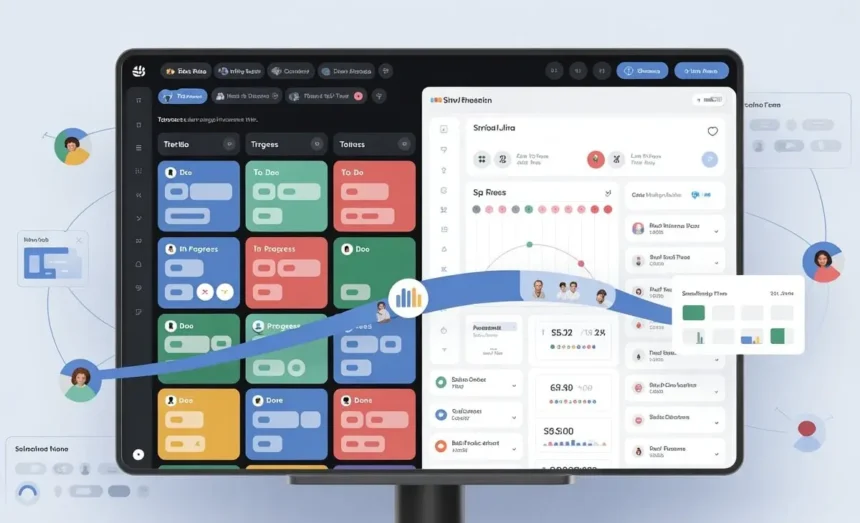In the modern business environment, tools for managing projects are pivotal to collaboration and efficiency. Businesses are reliant on platforms that assist in planning, tracking, and executing various tasks. For most organizations, the concern is not if they should implement a software solution for managing projects, but which software is the most appropriate to use: Trello or Jira.
Both software solutions provide distinct advantages and serve the differing needs of various teams, but when used together, they form an effective combination that improves order, clarity, and efficiency. Understanding the real benefits of integrating these software solutions is explained in more detail at Trello or Jira.
Introduction to Trello and Jira
As tools in project management, Trello and Jira are some of the most well-known and widely used, with each differing in its purpose. Trello is appreciated for its user friendliness, minimalism, and visual formats, and is more suited for teams that like simple, intuitive task boards. Jira is a more powerful and complex solution used by software development and IT teams, as it is more advantageous for project tracking and report generation.
In order to make the decision between Trello and Jira, it is important to analyze the primary benefits each software solution offers to help integrate for improved efficiency. The Trello system of cards in tracking tasks is flexible, while Jira’s complex and thorough issue tracking and project reporting provide a level of order and control.
When companies link the two tools, they receive Trello’s versatility for routine operations and task management along with Jira’s proficiency for deep project analysis. Integration strengthens inter-department coordination by merging creative and managerial, and technical workflows using a single platform.
Now, all cohesive teams can operate with optimal clarity and all automation potential. All interdependent tasks can be tracked, and all deadlines can be met.
Benefits of Integrating Trello and Jira for Teams
Trello and Jira integration offer a seamless transition for teams in different business functions to work without the need to switch tools. The integration resolves the question of using Trello or Jira by allowing both to operate in unison and improving the transfer of data.
Consider a scenario whereby one business function, say the marketing function, is using Trello to plan a campaign while the other function, say the development function, is using Jira to control sprints. Integration of the tools allows all updates, tasks, and relevant files to be linked across the two systems.
This new approach reduces potential errors, ensures all stakeholders are working toward the same goal, and saves all team members the effort of tracking duplicate tasks. Everyone saves time.
Accountability is one of the many benefits of having integrated systems in place. Each individual within a team is able to track dependencies and priorities to a greater extent, which improves the allocation of time and overall delivery of the project. The collaboration is from the simplicity of Trello and the precision of Jira.
Setting Up Trello and Jira for Seamless Collaboration
Successful integration or collaboration begins with clarity and structure. Regardless of whether your team prefers Trello or Jira, the setup must guarantee smooth communication between the two systems.
The initial phase consists of utilizing the built-in integrations or external software, such as Unito or Zapier, to bridge the two platforms. These technologies enable automatic synchronization of boards, tasks, and updates to ensure seamless Trello and Jira integration. After establishing a connection, teams can link Trello cards to Jira issues, thereby guaranteeing task representation on both systems.
Setting clear permissions and visibility is the next integration step. Teams must determine who can see, edit, or move tasks to ensure the integrity of the system. Proper notification systems can keep members updated on task movements and other important data, eliminating the need for pointless notifications.
Once the integration is properly configured, it creates a synchronized workspace where innovative ideas can be turned into reality. The integration improves the overall coordination of a project, reduces the number of delays, and creates a more streamlined project lifecycle.
Workflow Automation with Trello and Jira Integration
Automation with Trello or Jira Integration captures and eliminates unproductive time. This allows your team to concentrate on value-adding tasks.
In integrated workflows, actions in one tool trigger correspondence actions in the paired tool, automating the closed-loop systems. Moving a Trello card to “Done” might prompt the automation to close the corresponding issue in Jira. Likewise, automating Trello board updates syncs non-technical team members’ task statuses with Jira updates on tech team workflows.
This level of sync means that all divisions have up-to-minute relevant data without the need to switch tools continually. Automated systems improve order in your processes and workflows.
Day after day, automation in unmonitored systems syncs orders, allows updates in real time, and task completion remains on schedule to meet deadlines. With everything working harmoniously, efficiency increases.
Enhancing Communication and Transparency
Effective communication is the glue that holds a team together. When multiple departments depend on differing systems, structure collapse is inevitable. Integrating Trello and Jira closes this gap. Every employee, regardless of their function, whether on the creative, operational, or technical side, has the ability to look at important updates without having to log into several different systems. Such accessibility helps avoid miscommunication and assists everyone with understanding the project guidelines and each person’s roles and responsibilities.
Integration helps with accountability. Team leads notice and pinpoint slowdowns or stalled work, while employees can discern their role at the individual task level in the big picture of the project. It becomes straightforward to provide regular status updates and reduce the need for unnecessary check-in meetings.
Trello and Jira integration enable the creation of open systems for communication and provide employees with multiple levels of trust and collaboration.
Real-time Project Tracking and Reporting in Trello or Jira
Integration between Trelo and Jira excels in real-time visibility, which is important for successful project management. With the tools aligned, everyone can check on project milestones without having to switch out of their window.
Jira lets users analyze many reports to determine tasks like sprint velocity and time taken for issue resolution. Trello allows users to see a visual representation of tasks that are in progress. Used together, both tools provide the necessary information to run teams effectively.
Integration allows for even greater consistency between the two systems. Data-entry reports that are manual are updated in Trello and then automatically in Jira. From this, time can be saved and ensured that human errors are minimized, therefore giving managers the ability to make precise decisions that are reliant on reports.
Management can be positive and demonstrate real-time tracking and data entry. Anticipating problems is better than waiting for a situation to arise. Easily identify and resolve complex situations before they escalate. There is a balance in the system’s work design that improves the efficiency and the overall function of the system.
Best Practices for Maximizing Integration Efficiency in Trello or Jira
Best practices are essential to support integrations. Trello or Jira performing teams are built in considerable order. Automated processes are best structured to support cross-functional collaboration on a consistent basis. Monitoring order systems and adjusting controls before automation provides time to identify relevant reporting channels. One clear reporting system for all control enhances predictability with minimal confusion.
Last, all members of the team should be trained on the systems. The systems should promote collaboration and consistent order. Clear systems that direct people should be in place. Clear reporting channels and task systems should be in place.
Performance audits on a periodic basis tell organizations how efficiency is impacted by integration within the organization. In the case of organizations looking for integration opportunities, efficiency metrics such as completion time of varying tasks, as well as response time for different tasks, are useful.
When all teams put the practice as scheduled in all the tools for integration, the integration of Trello and Jira goes way beyond being a mere advantage for convenience. It becomes a powerful strategic asset for the organization that allows a firm to achieve sustained innovation and growth.
Conclusion and Future Trends in Project Management Tools Integration
Seamless collaboration on different tools and applications for project management is the next big thing. Choosing Trello or Jira will likely become a thing of the past as integration will become the norm. Enhanced integration within tools will allow organizations to focus on communication and precision collaborative work to deliver projects on time.
Hot trends within technology will focus on advanced integration that employs tools such as automation, artificial intelligence, and predictive analytics to resolve a project’s workflow issues. Organizations that integrate diverse tools will improve their operational efficiency.
Unifying, flexible, integrated processes will help to achieve operational efficiency. Integration of Trello and Jira is about operational efficiency and sustaining innovation, and it is the key to collaboration and functional integration of disparate teams within an organization.
For companies looking to enhance collaboration within their teams, guidance from specialists streamlining the process as well as optimizing digital workflows and project management solutions assists teams with realizing their potential through productive searches for integration are the types of services offered by Coastal IT Services.







